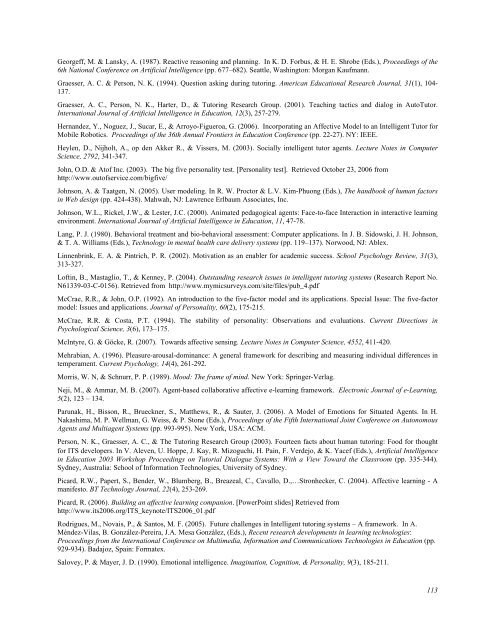April 2012 Volume 15 Number 2 - Educational Technology & Society
April 2012 Volume 15 Number 2 - Educational Technology & Society
April 2012 Volume 15 Number 2 - Educational Technology & Society
You also want an ePaper? Increase the reach of your titles
YUMPU automatically turns print PDFs into web optimized ePapers that Google loves.
Georgeff, M. & Lansky, A. (1987). Reactive reasoning and planning. In K. D. Forbus, & H. E. Shrobe (Eds.), Proceedings of the<br />
6th National Conference on Artificial Intelligence (pp. 677–682). Seattle, Washington: Morgan Kaufmann.<br />
Graesser, A. C. & Person, N. K. (1994). Question asking during tutoring. American <strong>Educational</strong> Research Journal, 31(1), 104-<br />
137.<br />
Graesser, A. C., Person, N. K., Harter, D., & Tutoring Research Group. (2001). Teaching tactics and dialog in AutoTutor.<br />
International Journal of Artificial Intelligence in Education, 12(3), 257-279.<br />
Hernandez, Y., Noguez, J., Sucar, E., & Arroyo-Figueroa, G. (2006). Incorporating an Affective Model to an Intelligent Tutor for<br />
Mobile Robotics. Proceedings of the 36th Annual Frontiers in Education Conference (pp. 22-27). NY: IEEE.<br />
Heylen, D., Nijholt, A., op den Akker R., & Vissers, M. (2003). Socially intelligent tutor agents. Lecture Notes in Computer<br />
Science, 2792, 341-347.<br />
John, O.D. & Atof Inc. (2003). The big five personality test. [Personality test]. Retrieved October 23, 2006 from<br />
http://www.outofservice.com/bigfive/<br />
Johnson, A. & Taatgen, N. (2005). User modeling. In R. W. Proctor & L.V. Kim-Phuong (Eds.), The handbook of human factors<br />
in Web design (pp. 424-438). Mahwah, NJ: Lawrence Erlbaum Associates, Inc.<br />
Johnson, W.L., Rickel, J.W., & Lester, J.C. (2000). Animated pedagogical agents: Face-to-face Interaction in interactive learning<br />
environment. International Journal of Artificial Intelligence in Education, 11, 47-78.<br />
Lang, P. J. (1980). Behavioral treatment and bio-behavioral assessment: Computer applications. In J. B. Sidowski, J. H. Johnson,<br />
& T. A. Williams (Eds.), <strong>Technology</strong> in mental health care delivery systems (pp. 119–137). Norwood, NJ: Ablex.<br />
Linnenbrink, E. A. & Pintrich, P. R. (2002). Motivation as an enabler for academic success. School Psychology Review, 31(3),<br />
313-327.<br />
Loftin, B., Mastaglio, T., & Kenney, P. (2004). Outstanding research issues in intelligent tutoring systems (Research Report No.<br />
N61339-03-C-0<strong>15</strong>6). Retrieved from http://www.mymicsurveys.com/site/files/pub_4.pdf<br />
McCrae, R.R., & John, O.P. (1992). An introduction to the five-factor model and its applications. Special Issue: The five-factor<br />
model: Issues and applications. Journal of Personality, 60(2), 175-2<strong>15</strong>.<br />
McCrae, R.R. & Costa, P.T. (1994). The stability of personality: Observations and evaluations. Current Directions in<br />
Psychological Science, 3(6), 173–175.<br />
McIntyre, G. & Göcke, R. (2007). Towards affective sensing. Lecture Notes in Computer Science, 4552, 411-420.<br />
Mehrabian, A. (1996). Pleasure-arousal-dominance: A general framework for describing and measuring individual differences in<br />
temperament. Current Psychology, 14(4), 261-292.<br />
Morris, W. N, & Schnurr, P. P. (1989). Mood: The frame of mind. New York: Springer-Verlag.<br />
Neji, M., & Ammar, M. B. (2007). Agent-based collaborative affective e-learning framework. Electronic Journal of e-Learning,<br />
5(2), 123 – 134.<br />
Parunak, H., Bisson, R., Brueckner, S., Matthews, R., & Sauter, J. (2006). A Model of Emotions for Situated Agents. In H.<br />
Nakashima, M. P. Wellman, G. Weiss, & P. Stone (Eds.), Proceedings of the Fifth International Joint Conference on Autonomous<br />
Agents and Multiagent Systems (pp. 993-995). New York, USA: ACM.<br />
Person, N. K., Graesser, A. C., & The Tutoring Research Group (2003). Fourteen facts about human tutoring: Food for thought<br />
for ITS developers. In V. Aleven, U. Hoppe, J. Kay, R. Mizoguchi, H. Pain, F. Verdejo, & K. Yacef (Eds.), Artificial Intelligence<br />
in Education 2003 Workshop Proceedings on Tutorial Dialogue Systems: With a View Toward the Classroom (pp. 335-344).<br />
Sydney, Australia: School of Information Technologies, University of Sydney.<br />
Picard, R.W., Papert, S., Bender, W., Blumberg, B., Breazeal, C., Cavallo, D.,…Stronhecker, C. (2004). Affective learning - A<br />
manifesto. BT <strong>Technology</strong> Journal, 22(4), 253-269.<br />
Picard, R. (2006). Building an affective learning companion. [PowerPoint slides] Retrieved from<br />
http://www.its2006.org/ITS_keynote/ITS2006_01.pdf<br />
Rodrigues, M., Novais, P., & Santos, M. F. (2005). Future challenges in Intelligent tutoring systems – A framework. In A.<br />
Méndez-Vilas, B. González-Pereira, J.A. Mesa González, (Eds.), Recent research developments in learning technologies:<br />
Proceedings from the International Conference on Multimedia, Information and Communications Technologies in Education (pp.<br />
929-934). Badajoz, Spain: Formatex.<br />
Salovey, P. & Mayer, J. D. (1990). Emotional intelligence. Imagination, Cognition, & Personality, 9(3), 185-211.<br />
113

















